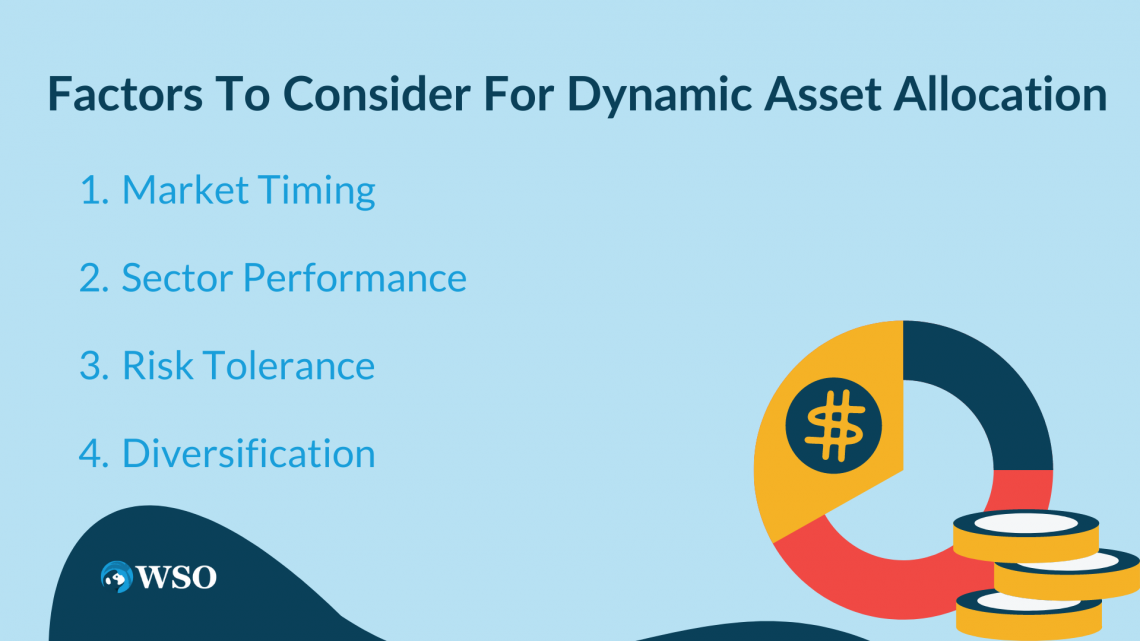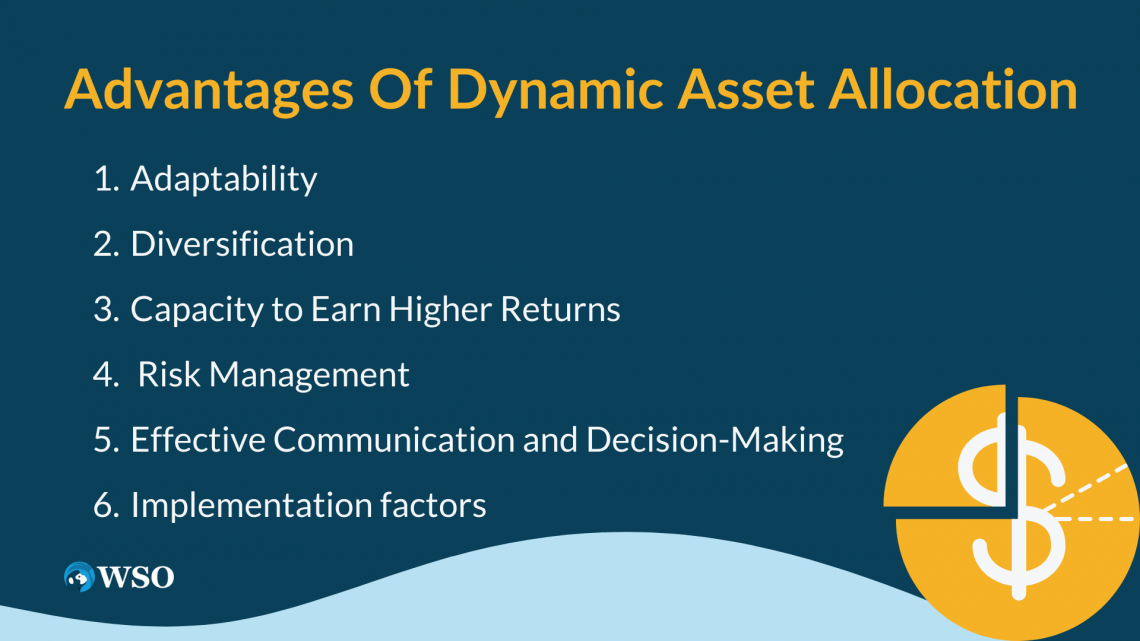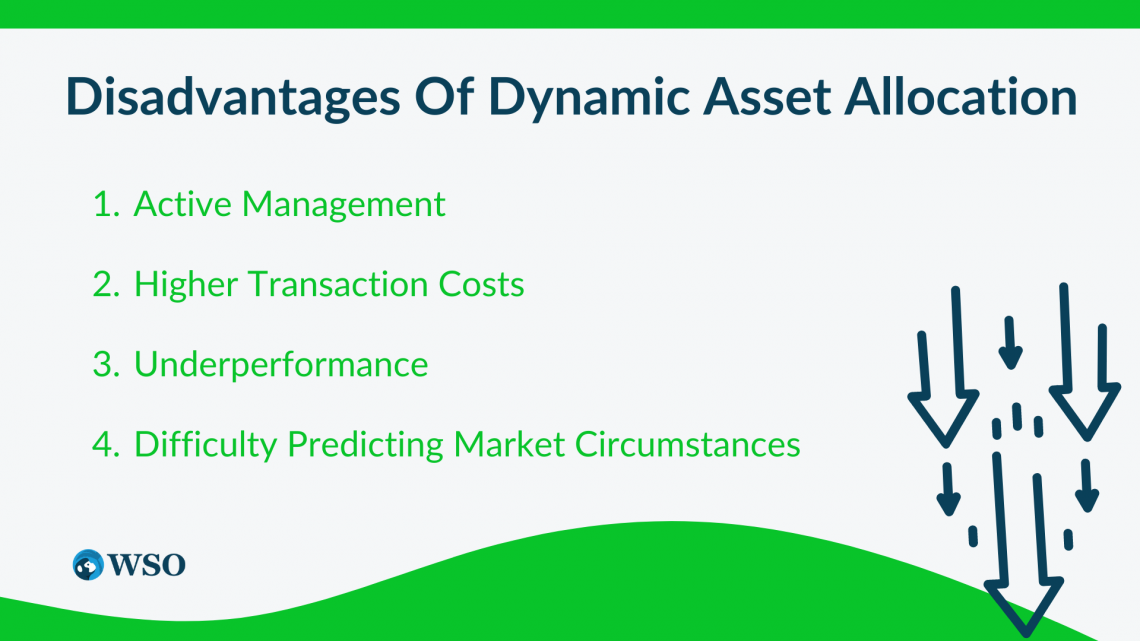Dynamic Asset Allocation
It involves constant analysis of the trends in the market to reduce risk and maximize returns.
What is Dynamic Asset Allocation?
Dynamic asset allocation (DAA) is an active investment strategy involving constant analysis of the trends in the market to reduce risk and maximize returns.

To process this allocation method, investors must evaluate the performance of the fixed income securities, real estate funds, commodities, and many other securities to understand their up and down pattern for potential returns.
Based on an investor's analysis, investors proactively modify the portfolio's asset allocation, moving investments between different or within the same asset class to balance potential rewards and risk exposure to the best possible extent.
DAA's main objective is to take advantage of possibilities for better returns when market circumstances are favorable while limiting the effects of market volatility or downturns.
Investors attempt to position themselves advantageously in various market circumstances by actively monitoring and modifying the portfolio's asset allocation, potentially improving their total investment performance.

It is typically managed by fund managers rather than individual investors. This is an active management strategy where a portfolio needs to be constantly altered based on moving up or down portfolio positions.
The fund management would carefully assess market conditions and related trends to decide which assets to hold, sell, or buy.
Instead of concentrating simply on the underlying securities, the actual emphasis is placed on properly allocating asset classes.
Key Takeaways
- Dynamic asset allocation involves adjusting portfolio investments based on market conditions to optimize returns and manage risks effectively.
- DAA seeks to benefit from advantageous market conditions while minimizing volatility consequences.
- Diversifying asset classes rather than merely individual assets is the focus.
- Dynamic Asset Allocation is a very important concept for managing investments actively based on market conditions.
- Seeking professional advice can benefit any investment approach but is not required for successfully implementing DAA.
Example Of Dynamic Asset Allocation
Let us take a look at the circumstances as an example.

An investor using DAA may elect to raise their allocation to real estate investment trusts (REITs) or other real estate-related assets if the real estate market is enjoying a substantial boom.
In contrast, the investor may decide to minimize their exposure to real estate assets and devote more funds to other asset classes, such as equities or bonds, if the real estate market is having difficulties or exhibiting indicators of a prospective slump.
DAA requires ongoing assessment of market circumstances and other pertinent variables. Assessing the current developments of the real estate market entails assessing a range of indicators, such as housing market statistics, rental vacancy rates, or construction activities.
Factors To Consider For Dynamic Asset Allocation (DAA)
It has many factors to consider before making it work in a portfolio. The following are the factors to consider:

1. Market Timing
Market timing is very important for the dynamic asset allocation to consider before making it work, as it depends on the active timing strategy to have a good market return.
For example, if an investor anticipates a bullish market, they may raise their allocation to equities to benefit from future price appreciation. Market timing can assist in risk management within a portfolio.
During instances of predicted market downturns or increased volatility, investors may limit their exposure to higher-risk assets and shift to more defensive investments such as bonds or cash. This can help safeguard the portfolio from catastrophic losses.
Note
Investors may improve portfolio performance by actively modifying asset allocation based on market conditions when compared to a static allocation approach.
2. Sector Performance
Sector rotation entails altering allocation to various market sectors in response to market conditions. This method lets investors capitalize on short-term market moves while diversifying their holdings.
For example, an investor following this technique may expand their exposure to the technology sector if they anticipate great success.
Investing in stocks or ETFs that are based on the technology sector can be achieved by rebalancing. If they anticipate that the healthcare sector will underperform, they may reduce their allocation to that sector.
Note
A thorough awareness of market trends and identifying sectors anticipated to outperform or underperform are essential for successful sector rotation.
In dynamic asset allocation, risk tolerance is an important factor to consider. It refers to a person's ability and willingness to tolerate the risks and losses connected with certain investment strategies.
Understanding one's risk tolerance while implementing dynamic asset allocation is critical since it influences allocation decisions made in response to changing market conditions.
Investors who are risk lovers may invest a higher proportion of their portfolio in higher-risk assets. On the other hand, investors with lower risk tolerance may want a more cautious allocation that prioritizes capital preservation.
Note
Individual risk tolerance varies according to financial goals, time horizons, and emotional resilience. Investors must objectively analyze risk tolerance and verify that their DAA strategy matches risk preferences and investment goals.
4. Diversification
Asset correlations can vary, especially during times of economic instability. As a result, investors should not make selections based purely on historical correlations.
Conversely, diversification entails spreading assets across several asset classes, sectors, and locations to lessen concentration risk.
Investors might consider diversifying depending on factors such as asset prices and crowded holdings rather than historical tendencies. This strategy seeks to reduce the risks associated with market downturns while also capitalizing on opportunities in undervalued or less crowded assets.
Diversification in dynamic asset allocation is intended to produce a portfolio that is not unduly reliant on the performance of any single asset, hence increasing resilience and improving returns.
How Does Dynamic Asset Allocation Work
It is an investment approach in which the composition of a portfolio is actively adjusted in response to changing market circumstances and other relevant factors.

To comprehend the current situation of the financial markets, market indicators, economic data, and trends are analyzed. Investors set their risk and return targets, considering aspects such as risk tolerance and desired level of returns.
They then evaluate the previous performance and projected growth prospects of various asset types, such as equities, fixed-income instruments, and real estate.
Investors must regularly rebalance their portfolios to maintain the proper balance after choosing an asset allocation strategy.

If particular asset classes have strayed significantly owing to market fluctuations, they buy or sell assets to restore the intended allocation. Investors manage assets actively for the good performance of individual stocks.
During the implementation and execution phase, trades are executed to alter the portfolio under the dynamic asset allocation plan.
An investor must make the portfolio perform better frequently and make approximate changes for market and economic conditions. The main purpose is to maximize returns by reducing risk when the market is favorable while protecting against potential losses.
Advantages Of Dynamic Asset Allocation (DAA)
The following are the advantages of it, which offers the investors a positive impact in using this strategy,

1. Adaptability
Dynamic asset allocation allows you to change the composition of your portfolio in response to changing market circumstances or other relevant considerations.
Such adaptability enables investors to adjust their portfolio's risk and return characteristics and potentially accomplish their investment objectives.
2. Diversification
By dynamically shifting investments across several asset classes, investors can gain more diversification.
Diversification reduces total portfolio risk and volatility by spreading investments across multiple sectors and types of securities.
3. Capacity to Earn Higher Returns
The capacity to change the portfolio composition in response to market opportunities enables investors to profit from favorable market circumstances and create higher returns possibly.
Note
Investors can capitalize on market cycles and trends as they occur by actively managing their portfolios.
4. Risk Management
Dynamic asset allocation offers effective risk management by altering the portfolio mix in response to risk tolerance or market conditions changes.
Investors can reduce risk by selling overpriced assets and reallocating to underpriced assets, so protecting their portfolio from future losses.
5. Effective Communication and Decision-Making
It can help investors and their advisors communicate more effectively. It aids in explaining the reasoning behind portfolio decisions and emphasizes the significance of various asset classes.
Note
DAA also tests input modeling and assumptions, resulting in a more robust investing plan.
6. Implementation factors
For private investments, it allows for overlaying implementation factors such as turnover limitations or progressive ramp-up and lock-up periods.
These considerations improve the strategy's effectiveness and link it with specific investment goals.
Disadvantages Of Dynamic Asset Allocation (DAA)
The following are the disadvantages of dynamic asset allocation, which has a negative effect considering dynamic asset allocation:

1. Active Management
Dynamic asset allocation necessitates investors to make timely and correct decisions on updating their portfolio mix in response to market movements.
Poor timing decisions can lead to missed opportunities or avoidable losses, emphasizing the significance of making educated decisions at the appropriate moment.
Furthermore, regular portfolio monitoring and adjustment can be time-consuming and demanding for investors, necessitating significant work and attention.
2. Higher Transaction Costs
The DAA frequently can result in higher transaction costs. These costs include brokerage fees, bid-ask spreads, and other charges involved with purchasing and selling shares.
Note
Rapid portfolio turnover might result in taxable events, thereby increasing the investor's tax bill and lowering after-tax profits.
3. Underperformance
It presumes that investors can properly foresee market conditions and alter their portfolios accordingly.
If investors fail to predict the market condition, it will adversely impact their portfolios in the long run.
Note
The ability to continuously generate accurate predictions and make appropriate modifications is critical to the success of dynamic asset allocation.
4. Difficulty Predicting Market Circumstances
The intricacy of predicting market circumstances creates a substantial obstacle to dynamic asset allocation. Despite the use of advanced statistical models, unforeseen occurrences or market shocks might occur, rendering predictions incorrect.
Various factors influence market behavior, including macroeconomic trends, geopolitical developments, and investor emotion. The interaction of these factors can be complex and difficult to forecast precisely.
Investing in Dynamic Asset Allocation Funds
Dynamic Asset Allocation Funds (DAAFs) can be beneficial if managed well, but investors should not rely solely on this category for their entire investment portfolio.

Instead, investors should carefully consider their risk appetite, understanding of market timing, and investment horizon when allocating funds to DAAFs.
These funds can be suitable for investors seeking low volatility within equities, who lack expertise in timing market entries and exits, and who have a medium risk tolerance and a willingness to remain invested for at least 3 to 5 years.
Before investing in DAAFs, investors should assess their comfort level with volatility and risk. It should be noted that these products may not provide similar returns to actively managed equities funds with higher equity exposure, often up to 90%.
While well-managed DAAFs may offer fewer declines during market collapses than pure equity funds, DAAFs saw maximum drawdowns ranging from -12% to -34% in CY2020, while the Sensex (a benchmark index) fell by -38%.
This suggests that DAAFs are not completely immune to downside risk, and investors should be aware that their principal investment may still be jeopardized.




or Want to Sign up with your social account?